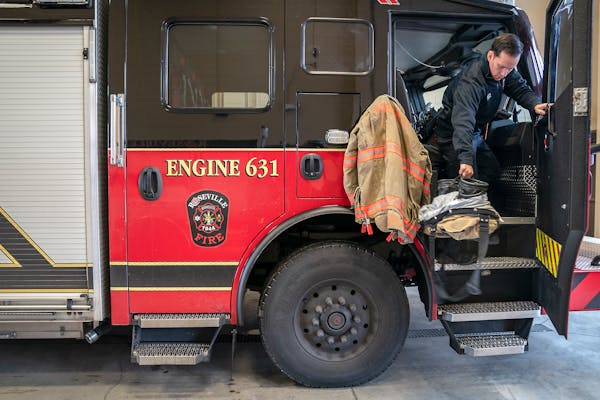The pandemic has worsened after brief improvements over the Thanksgiving holiday, reaching levels not seen in Minnesota since last December, before COVID-19 vaccine was available.
Minnesota on Monday reported an 11.5% positivity rate of COVID-19 diagnostic tests — an indicator of widespread viral transmission — and a 2021 record infection rate in the week ending Dec. 3. The 1,677 COVID-19 hospitalizations in Minnesota on Friday included 342 people needing intensive care.
Minnesota might be following the trend of mountain states such as Colorado and Montana, which saw declines in their coronavirus infections after peaking last month. But hospital leaders are bracing for sustained pressure. Only 13 of 1,012 staffed adult ICU beds were open in Minnesota as of Friday.
Leaders of nine Minnesota hospital systems signed a full-page ad in the Star Tribune and other publications Sunday asking people to help by seeking COVID-19 vaccinations and boosters and by using mask-wearing and social-distancing practices to reduce viral spread.
"At any time, you or a loved one might need our support," they wrote, "Heart attacks. Car accidents. Cancer. Stroke. Appendicitis. Now, an ominous question looms: Will you be able to get care from your local community hospital without delay? Today, that's uncertain."
Pressure on hospital emergency rooms worsened over the weekend when COVID-19 cases combined with accidents and injuries from the first major winter storm of the season.
"We did see a few significant injuries related to motor vehicle crashes and our typical injuries related to slipping on icy sidewalks," said Dr. Thomas Wyatt, a senior director of Hennepin Healthcare's ER at HCMC in Minneapolis.
State leaders believe Minnesota is a victim of timing, with a COVID-19 wave fueled by a highly infectious delta variant migrating from the South this summer to the Midwest this fall just as early vaccine recipients began to experience waning immunity. Boosters are recommended to restore immunity for adults six months after their initial Pfizer or Moderna vaccinations, or two months after their Johnson & Johnson vaccinations.
Minnesota has the nation's third highest rate of new coronavirus infections, according to the Centers for Disease Control and Prevention, but there are hopeful signs. CDC trend data indicate that Minnesota's infection rate may have peaked on Dec. 6, and Mayo Clinic's 14-day pandemic forecast predicts that infection rates will begin to drop next week.
Minnesota ranks second among states with 43% of fully vaccinated adults receiving boosters, and that progress combined with immunity after recent infections is affecting Mayo's forecast, said Curtis Storlie, a creator of Mayo's predictive COVID-19 model.
Meanwhile, he said states such as Missouri and Kentucky that already had delta COVID-19 waves this summer are seeing second waves this winter as their vaccine recipients experience waning immunity.
These states are likely to experience "a double delta peak, whereas Minnesota is more likely to only have the one," Storlie said.
The Minnesota Department of Health on Monday reported another 3,655 infections and 46 COVID-19 deaths, raising its pandemic toll to 960,425 infections and 9,918 deaths. The newly reported deaths include a Becker County resident age 25 to 29, the state's 34th COVID-19 death involving someone younger than 30.
Breakthrough infections have contributed to the latest wave, prompting the call for boosters, according to the latest state data released Monday. Fully vaccinated Minnesotans made up 32% of coronavirus infections and 35% of COVID-19 deaths from May through September, but 43% of infections and 45% of COVID-19 deaths in the five-week period ending Nov. 13.
Relative risks remain highest among the roughly 1 million unvaccinated Minnesotans, who make up the majority of COVID-19 cases and deaths but the minority of the state's population.
The median age of COVID-19 deaths from May through mid-November was 69 for the unvaccinated and 82 for the vaccinated, according to state health data. And 19% of recent COVID-19 deaths in the unvaccinated population involved people who were otherwise healthy and had no underlying health conditions. That compares with 11% of the deaths in the vaccinated population.
Gov. Tim Walz on Monday celebrated the drawing of a second $100,000 college scholarship for vaccinated Minnesota children, and urged parents to sign their children ages 12 to 17 up for the final, third drawing later this year. The winner, 16-year-old Ben Truax of Rochester, was motivated by his mom, a hospital nurse who treats COVID-19 patients.
"We have also experienced the loss and tragedy on the flip side for those not getting vaccinated," Truax said in a statement from the governor's office, saying his relatives have lost friends to the infectious disease.
Holidays have been disruptive to COVID-19 trends throughout the 21-month pandemic, partly because people seek testing in advance of family gatherings and travels but not on the holidays themselves.
Thanksgiving this year mirrored the Education Minnesota weekend in October and last year's Thanksgiving week, when COVID-19 numbers briefly declined before rising again. Christmas 2020 saw a reverse trend, briefly disrupting the end of the state's second and most severe pandemic wave.
Health officials remain concerned about family gatherings over Christmas this year and their potential to fuel viral spread.
Two infections have been identified in Minnesota with an omicron variant that spreads even faster and could replace delta as the dominant strain. Omicron might produce fewer severe illnesses, though, based on early findings out of South Africa where the variant was discovered.

Minneapolis reaches $150k settlement with eyewitness of George Floyd's murder

Israel-Hamas war creates 'really fraught times' at Minn. colleges

Rare and fatal brain disease in two deer hunters heightens concerns about CWD

